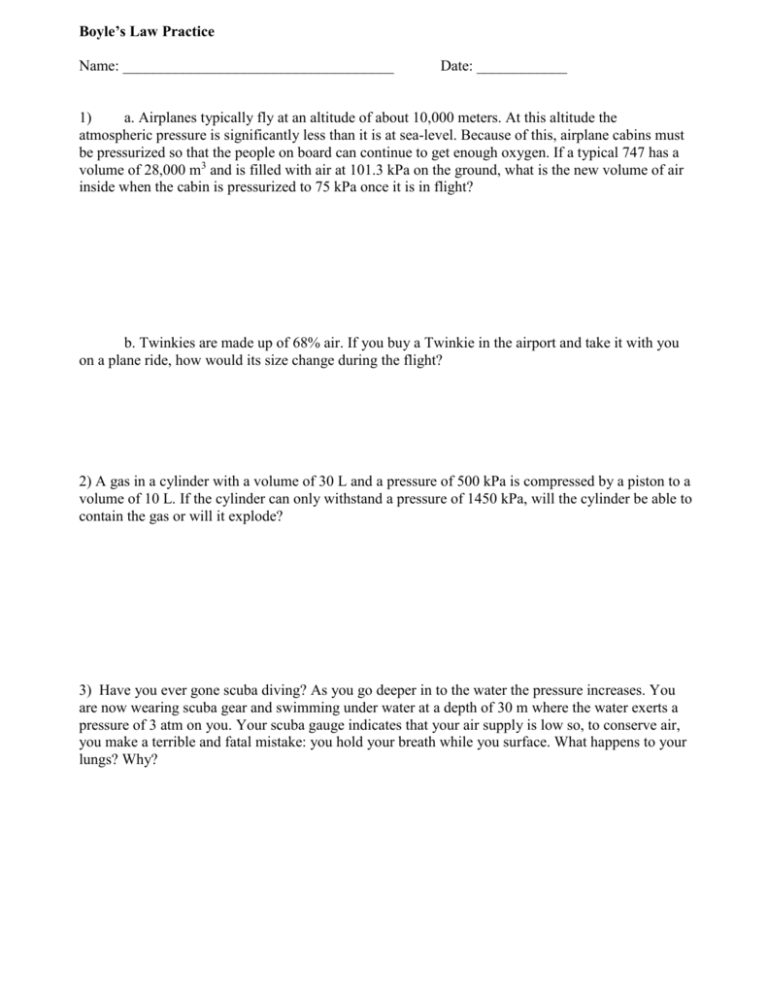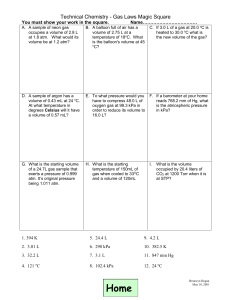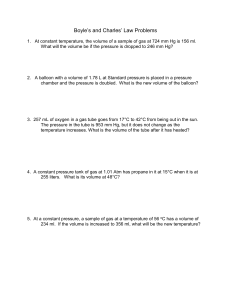Boyles Law Practice
advertisement

Boyle’s Law Practice Name: ____________________________________ Date: ____________ 1) a. Airplanes typically fly at an altitude of about 10,000 meters. At this altitude the atmospheric pressure is significantly less than it is at sea-level. Because of this, airplane cabins must be pressurized so that the people on board can continue to get enough oxygen. If a typical 747 has a volume of 28,000 m3 and is filled with air at 101.3 kPa on the ground, what is the new volume of air inside when the cabin is pressurized to 75 kPa once it is in flight? b. Twinkies are made up of 68% air. If you buy a Twinkie in the airport and take it with you on a plane ride, how would its size change during the flight? 2) A gas in a cylinder with a volume of 30 L and a pressure of 500 kPa is compressed by a piston to a volume of 10 L. If the cylinder can only withstand a pressure of 1450 kPa, will the cylinder be able to contain the gas or will it explode? 3) Have you ever gone scuba diving? As you go deeper in to the water the pressure increases. You are now wearing scuba gear and swimming under water at a depth of 30 m where the water exerts a pressure of 3 atm on you. Your scuba gauge indicates that your air supply is low so, to conserve air, you make a terrible and fatal mistake: you hold your breath while you surface. What happens to your lungs? Why? 4) Divers get “the bends” if they come up too fast because the gas in their blood expands, forming bubbles in their blood. If a diver has 0.05 L of blood under a pressure of 250 atm, then rises very quickly to a depth where his blood has a pressure of 50.0 atm, what will the volume of gas in his blood be? Do you think that that would harm him? 5) I have added 15 L of air to a balloon at sea level (standard pressure.) If I take the balloon with me to Denver, where the air pressure is 0.85 atm, what will the new volume of the balloon be? 6) Here’s one more application: say I happened to have a copper tube that was 100 cm long and a radius of 1 cm. Empty, the tube would actually be filled with air at 1atm, but let’s figure out how much pressure that tube would be under if I compressed its volume to ¼ of the original. First, you would have to calculate the original volume from the length and diameter knowing that: V = πr2h The final volume is ¼ the original volume, so V2 = ¼ V1 Once you calculate the original and final volume, you can plug these numbers, along with the initial pressure in the Boyle’s Law equation to solve for the final pressure.











